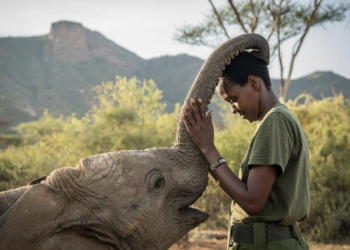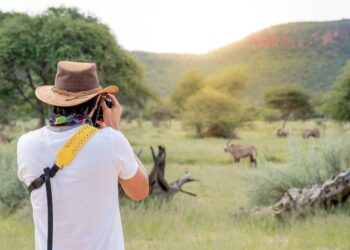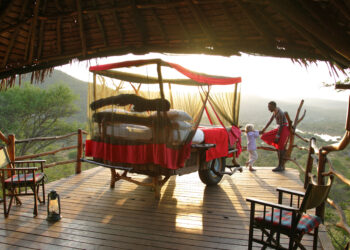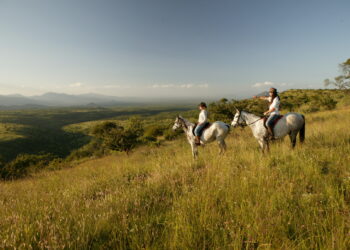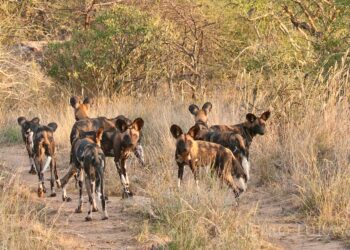1. The Savuti & Linyanti Concession, Botswana

Botswana’s Chobe National Park is not off the beaten track. But even big, headline-grabbing wildlife areas have corners that few explore. The Savuti – meaning ‘mystery’ – is such a place. Lying on Chobe’s western border, this game-packed wilderness is difficult to reach (flying in is your best bet), so relatively few do. It is known for its huge prides of elephant-hunting lions (a rare sight) and spotted hyena. It also has its own great migration: in November, zebra, wildebeest and buffalo in their thousands move south into the Savuti, looking for fresh grasses, before returning north in February. The area is characterised by the enigmatic Savuti Channel, which runs 100km from the Chobe River to Savuti marsh; it’s often bone-dry but periodically floods spectacularly. Along its northerly banks you’ll find the Linyanti Concession, a remote, private reserve, home to huge elephant herds and wild dogs that might be seen hunting in packs. Tours often combine the Savuti and Linyanti in one wild trip.
Also see: Tiny Mokolodi Nature Reserve, just south of capital Gabarone, is Botswana’s only not-for-profit park. Its cycling routes offer a rare and unusual way of exploring the bush, while giraffe and rhino tracking tours take you thrillingly close to the action.
2. Majete Wildlife Reserve, Malawi

By the late 1990s poaching had devastated Majete Wildlife Reserve. There was very little left to see; indeed, the reserve didn’t receive a single visitor between 2000 and 2003. Then the NGO African Parks took over management of Majete and, over the subsequent years, the reserve has been transformed. More than 5,000 animals from 17 species have been brought in; the arrival of lions in 2012 completed the Big Five. But it has been the measures taken to stop poaching that have had the greatest impact. Not one rhino or elephant has been illegally killed in the reserve since they were introduced. Facilities have also improved. Lodges and campsites now include the luxurious Mkulumadzi, set within a private concession, and Thawale Lodge, revamped during lockdown, where the watering hole has become a prime spot for elephant sightings. In short, Majete is one of Africa’s great wildlife comebacks.
Also see: Another amazing story is that of Malawi’s Nkhotakota Wildlife Reserve. It was once home to 1,500 elephants but, due to poaching, by 2015 there were barely 100 left. This was when ‘Operation 500 elephants’ was put into action, as animals were shipped in from Liwonde National Park and Majete, restocking the numbers and revitalising the reserve.
3. Kidepo Valley National Park, Uganda

It doesn’t get much more remote than Uganda’s Kidepo Valley NP. Some 700km north of capital Kampala, on the border with South Sudan, spread across the sun-bleached grasslands of the Karamoja region, it is visited by few travellers. Those that do arrive may discover one of East Africa’s rarest sights: tree-climbing lions. It’s a quirk more readily associated with the big cats of Uganda’s Queen Elizabeth NP or Lake Manyara NP in Tanzania, and while it’s not common here, it does happen – a result of lions wanting to either escape irritating bugs on the ground or simply snag a cool breeze. When not scouring the branches of sausage trees for unconventional felines – or for the park’s 475 recorded species of birds – look out for cheetah. This is the only part of Uganda where you’ll find these stately cats, and sightings are reassuringly regular. Kidepo also rewards the adventurous traveller, with visits to the boiling hot springs of Kanangorok and day hikes into the Morungole Mountains, pit-stopping at Ik villages en route, offering challenges aplenty.
Also see: Mgahinga Gorilla NP – Uganda’s smallest national park – lives in the shadow of better-known Bwindi Impenetrable Forest. It is quite a trek to reach, nestled deep in the south-west between three extinct volcanoes, but hikes to visit the habituated group of mountain gorillas that live in the Virunga hills here are no less rewarding.
4. Gorongosa National Park, Mozambique

Mozambique’s brutal civil war, which raged from 1977 to 1992, had a devastating impact on the protected area of Gorongosa, at the southern tail of the Great Rift Valley. During this period the park lost some 90% of its wildlife. However, since 2004, when a US philanthropist teamed up with the Mozambican government, Gorongosa has been resurrected. Millions of trees have been replanted; wild dog, elephant, zebra, hippo and other species have been brought in; local people (a third of them women) have been trained as guides and rangers to help monitor and protect the wildlife. As a measure of the project’s success: fewer than 200 elephants survived the war, now 800 to 1,000 crash about the floodplains, woodlands and savannah, in the shadow of Mount Gorongosa. In 2018 a pack of 14 painted wolves (wild dogs) was released and has thrived; visits between August and September might be rewarded with sightings of exuberant pups emerging from their dens. It’s a lost world reborn.
Also see: Mountainous Chimanimani NP was only elevated to national park status in 2020 and lies across the border from the similarly named park in Zimbabwe, forming the Chimanimani Transfrontier Park. The area, also impacted by the war, remains little-visited but may yield sightings of rare mountain elephants.
5. Phinda Private Game Reserve, South Africa

The pangolin is thought to be the world’s most trafficked wild mammal. Its susceptibility to the worst of human impulses means that of the four species found in Africa, all are classified either ‘Vulnerable’ or ‘Endangered’. The Temminck’s pangolin is believed to be the most numerous, and the only species found in southern Africa. They haven’t been seen in KwaZulu-Natal since 1973; however, the South African province’s Phinda Private Game Reserve – which has a history of successfully running breeding programmes to supply other parks with lost populations of animals – is undertaking a reintroduction project. Tours at Phinda allow guests to assist with rhino, elephant and pangolin research, monitoring their progress in the wild. The reserve also offers bush walks, which may yield sightings of black rhino and red duiker, as well as Big Five game drives.
Also see: Samara Private Game Reserve in South Africa’s Eastern Cape has been rewilding a chunk of the semi-desert Great Karoo for 25 years; it is has reintroduced species such as cheetah, elephant, black rhino and lion, which were wiped out here in the late 19th century. It’s a compelling story of farmers turned conservationists. What’s more, only 30 guests are allowed to visit at any one time, so it never feels crowded.
6. Matusadona National Park, Zimbabwe

This forgotten park lies on the edge of Lake Kariba, the world’s largest man-made lake. Some 6,000 animals were relocated here (though many more weren’t) when the Zambezi Basin was flooded to form the lake in 1958. Today, Matusadona NP sits snugly on Kariba’s northern shore, squeezed between the Sanyati and Sengwa rivers and the Matuzviadonha hills from which it gains its name (the word translates as ‘falling dung’, likely in honour of the area’s lively elephant population). At its peak, the park’s density of lion and black rhino was impressive, but by the time its operation was taken over by African Parks in 2019, poaching had devastated numbers and few facilities were left. However, even as restoration work begins, Matusadona’s intrinsic wildness remains. Rugged hills sweep down to flat grassland plains, which in turn give way to petrified forest. Options include Jeep and walking safaris, which may bring you close to the park’s 1,000-strong herds of buffalo grazing on the plains. Or instead cruise the drowned woodlands where some 240 species of bird have been recorded, including African fish eagles – you might spot them swooping down to the water, talons primed for a catch.
Also see: Zimbabwe, despite its abundance of wildlife, is still off most travellers’ hit lists. Even its better-known national parks, such as Mana Pools – famous for its huge elephant population – has more pachyderms (around 11,500) than annual visitors (around 7,000). It’s a shame, as Mana Pools offers some incredible experiences, including canoe safaris along the Lower Zambezi, on which you can paddle gently past drinking elephants and grunting hippos.
7. Ruaha National Park, Tanzania

It’s odd that Tanzania’s second-largest national park, home to one of the biggest single populations of lions in Africa, is still one of its least known. Add to that more than 500 bird species, elephants migrating in their thousands, healthy populations of wild dog, leopard and cheetah, and the rare sight of greater and lesser kudu in the same area, and Ruaha’s anonymity becomes baffling. The answer perhaps lies in its remoteness. Only a tenth of the park, which sprawls across an isolated area of the Great Rift Valley, is given over to tourism; the rest is pure, unadulterated wilderness. Even in those parts of the park that visitors can explore, the low-impact approach here (there are just a handful of camps) means you will rarely see another soul, even during dry season (May-November) when sightings along the shrinking riverbanks are at their best. Ruaha’s large open plains and groves of fat baobabs flanked by rocky outcrops and inselbergs also ensure magical walking safaris, while fly camps allow you to forge deep into this lonely paradise.
Also see: Tanzania’s Rubondo Island NP occupies a forested isle in the south-west corner of Lake Victoria. Wild and uninhabited, it’s become a haven for rescued chimps after they were introduced in the 1960s (it began with 16; now there are more than 60). A lakeside camp offers a serene waterside stay and ample birding opportunities.
8. Zakouma National Park, Chad

In what has become a familiar story, the future of Chad’s oldest national park, Zakouma, was hanging in the balance until relatively recently. In the first decade of the 21st century, some 95% of its 4,000 elephants were slaughtered by poachers on horseback while civil war raged across the country (from 2005 to 2010). African Parks took over the running of Zakouma in 2010 and, with security now beefed up, no elephant has been poached here since 2016. Subsequently, small numbers of tourists have started to visit: this is now the closest national park to Europe where you can see the Big Five. Facilities are minimal. The nomadic eight-tent Camp Nomade, which sets up around the birding wetlands of Rigueik Pan for much of the year, is the plushest option. The more functional government lodge is now over 50 years old. But the unique wildlife is what makes Zakouma unmissable. Its riverine forests and grassland plains are home to half of Africa’s entire population of Kordofan giraffes as well as roan antelope, black-crowned cranes and vast herds of elephants.
Also see: The only other park in Chad commonly included on tours is the dramatic sandstone landscape of the Ennedi Natural and Cultural Reserve. It’s best known for birds, flora and the desert-adapted West African crocodile, which has learned to survive the arid climate by staying in caves and burrows when water is scarce.
9. Kunene Region, Namibia

As Africa’s landscapes change, so do its animals. Amid the parched, sandy bush of north-west Namibia’s Kunene Region, you can see incredible desert-adapted wildlife: elephant, rhino and lion thriving in the arid terrain. Indeed, while trends for wildlife are mostly on the downturn worldwide, Namibia’s desert-adapted black rhino population is increasing. But then, Namibia takes conservation very seriously: environmental protection is incorporated into its constitution and nearly half of the land is protected in some way, with communal conservancies covering one-fifth of the country. This pioneering model of land management sees Indigenous communities directly invested in monitoring and protecting wildlife, and directly benefiting from tourism enterprises operating there. Places such as the Desert Rhino Camp, in the vast 5,500 sq km Palmwag Concession of Damaraland, for example, works with local communities; people earn a livelihood while guests enjoy encounters with desert-adapted lion and black rhino with no one else for miles. Similarly, in the remote Kaokoveld, Conservancy Safaris run expeditions into the Torra Conservancy, which provide excellent rhino-tracking experiences, funds for conservation and employment opportunities.
Also see: Etaambura Camp, set in the hills above the holy plains of Onjuva, is both co-owned and run by Namibia’s Himba. Tradition has it that animals on the plains are protected by ancestral spirits, and strolls reveal evidence of genet and African wildcat amid the blooming bottle trees and purple-pod terminalia.
10. Mara North Conservancy, Kenya

What if you could witness the Great Migration without being surrounded by other binocular-waving tourists? In 2009 a group of Maasai landowners came together to protect what was becoming an increasingly degraded part of the Masai Mara National Reserve. They formed the Mara North Conservancy, partnering with a small number of lodges, camps and safari operators to safeguard the land and the futures of the 800-plus Maasai it supports. This created the largest (275 sq km) of the ‘Big Four’ conservancies within the reserve. Its low-impact, eco-focused tourism ensures not just a fair rent for its indigenous people, but ensures that the crowding found in other parts of the Mara doesn’t happen here. Visitors are limited to those staying within the conservancy, so when the huge herds of wildebeest and zebra pass through the golden grasses of its savannah each year (usually June-October), numbers at sightings are strictly controlled. Other wild wonders here include Leopard Gorge, where rocky outcrops offer cover for big cats to prey on impala and gazelle, and the Lemek Hills, a refuge for African wild dogs. Best of all, you’ll have these areas largely to yourself.
Also see: Among the Big Four conservancies in the Mara, Oi Kinyei was the first to be established. Here, among the rolling hills and grasslands, you’ll find the highest density of lions in any one area, so sightings (shared between just two camps) can be spectacular.
11. North Luangwa National Park, Zambia

Walking safaris were pioneered in Zambia in the 1950s. They are now legendary, particularly those in South Luangwa NP, which lies far enough off the beaten track to warrant ‘secret’ status itself. This patchwork of pristine woodland and plains still feels like a forgotten world, even if it’s one that comes with an increasing number of luxury camps. However, for those wanting to escape further, a short flight to its northern cousin (known as North Park) is a must. Walking safaris here pick their way along the shallow banks of the Mwaleshi tributary. In the dry season, this recedes, leaving a trail of pools that draws animals to the banks where no 4WDs are allowed. There are only three camps inside the park (operating June-October); Mwaleshi is walk-only while Takwela, opened in 2019, offers game drives into remote areas. The park is especially known for its large prides of lions, vast herds of buffalo and reintroduced black rhino, but the main allure is the intimacy of exploring one step at a time and sleeping out in the isolated bush, far from any other people.
Also see: Surprisingly, given its huge expanse, western Zambia’s Kafue NP (which is roughly the size of Wales) is very little visited. A balloon flight over its lonely Busanga Plains, where lions converge on wary antelope, makes for a truly unforgettable experience.
12. Somkhanda Game Reserve, South Africa

Some success stories go beyond conservation. The land that makes up this community-owned reserve in KwaZulu-Natal’s Zululand belongs to the Gumbi people, who were stripped of the rights to it in the 1960s under Apartheid. They only successfully won back their ancestral claim in 2005, as part of the post-Apartheid restitution. It was returned to them degraded from overgrazing, so they made the decision to set aside the bulk of the land for conservation, making it the first community-owned game reserve to emerge from this process. It’s a wonderful gift salvaged from a brutal past and affords jobs and income for the community. It also forms an important wildlife corridor alongside its two neighbouring reserves, while the success of its black rhino and wild dog breeding programmes has been encouraging. For travellers, it’s a rival to any of South Africa’s great parks in terms of sightings, with all the Big Five here, including both white and black rhino and an unusually high density of leopards.
Also see: Buffalo Ridge, in Madikwe Game Reserve, claims to be South Africa’s first 100% community-owned safari camp. Operated by the Balete Ba Lekgophung people, it’s a great base for exploring this reserve, where the Big Five are accompanied by brown hyena and aardwolf.
13. Akagera National Park, Rwanda

The Rwandan civil war saw so many tragedies. After it ended, the consequences continued for its wildlife. In 1994 Rwanda’s dispossessed Tutsi people were resettled along the Tanzanian border, encroaching on what was then part of Akagera National Park. Conflict with the local wildlife was inevitable as buffalo and zebra jostled alongside 700,000 cattle for grazing space. Poaching became rife and by 2002 the last of the park’s 300 lions had died, many of them poisoned by farmers. For a long time Akagera was a cautionary tale; now, a decade after its running was taken over by NGO African Parks, things have turned around for Central Africa’s largest protected wetland. The reintroductions of lion and black rhino are just one miracle; others have included keeping them alive and smoothing relations with villagers. For visitors, it means you can now see the Big Five just two hours’ drive from Kigali, yet the park still flies under the radar.
Also see: The mountain gorilla of the Virunga steal the headlines in Rwanda but spare time for chimp-trekking in the Nyungwe Forest NP. Sightings aren’t guaranteed but if you’re lucky you may have the chance to see their nests and observe their daily activities, from feeding to socialising.














